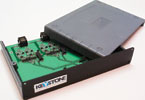

Keystone Electronic Solutions has announced the availability of ModBUS capability for its remote site monitor (RSM) solution. The new functionality seamlessly integrates with the existing RSM infrastructure, making it easy for clients to add to existing implementations. All that is required is to update the RSM software on the controller to the latest version of RSM to enable the ModBUS support.
John Eigelaar, Keystone director, explains: “Many clients are still using legacy SCADA and PLC protocols for large machinery, and so we came up with the idea of mapping ModBUS devices and exposing the monitoring points as if they are RSM devices. From a network management perspective, it is absolutely seamless as there is no difference in the way the devices are managed.”
According to Eigelaar, ModBUS devices can be accessed either with the ModBUS-over-TCP protocol through any of the onboard LAN ports or with the ModBUS serial RTU protocol through any of the existing RS-485 RSM monitoring buses.
ModBUS devices are reflected as fully integrated RSM monitoring devices from a network management point of view, and the ModBUS-enabled version supports all the features and functionality associated with the current RSM monitoring modules.
Devices can be added and configured through the onboard web-based configuration interface. ModBUS devices make use of pre-installed device mapping templates in order to simplify the configuration and commissioning of the devices. Device templates can easily be customised and distributed as an RSM software update from a central RSM software repository.
In order to ensure the widest possible protocol compatibility, only the core ModBUS messages have been implemented. The ModBUS data types are mapped to RSM data types in the following way:
* ModBUS coils/inputs RSM discrete inputs.
* ModBUS relays/outputs RSM discrete outputs.
* ModBUS input registers RSM analog inputs.
* ModBUS output registers RSM analog outputs.
A serial ModBUS gateway is available to expand the ModBUS capabilities of the RSM system. This gateway provides:
* Three fully isolated ModBUS master interfaces.
* Each of the master interfaces can be utilised in RTU or ASCII mode.
* All master interfaces support all standard baud rates up to 115 200 bps and can be clocked individually.
* All master interfaces can operate in either 2-wire half duplex or 4-wire full duplex mode.
* A fully programmable ModBUS routing table has been included in order to customise the ModBUS network topology.
* All gateway configuration settings can be done through the onboard web-based RSM configuration interface during installation and commissioning.
| Tel: | +27 12 460 4135 |
| Email: | [email protected] |
| www: | www.kses.net |
| Articles: | More information and articles about Keystone Electronic Solutions |

© Technews Publishing (Pty) Ltd | All Rights Reserved